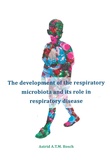The development of the respiratory microbiota and its role in respiratory disease

Bosch, Astrid
- Promoter:
- Prof.dr. E.A.M. Sanders & prof.dr. D. Bogaert
- Co-promoter:
- dr. M.A. (Marlies) van Houten
- Research group:
- Sanders
- Date:
- January 26, 2017
- Time:
- 12:45 h
Summary
Respiratory tract infections (RTI) are one of the most common paediatric diseases and a major reason for physician consultations and hospital admissions. The upper respiratory tract is the origin of respiratory infections and considered as natural niche of commensals and potential pathogenic bacteria, jointly forming a microenvironment (microbiota). Therefore the respiratory microbiota is thought to play an important role in protection against respiratory infections.
Colonisation of the upper respiratory tract is a dynamic process with acquisition and elimination of species, interactions among and between microbes and the host, and interference by environmental factors. These interactions may be disturbed by eliminating a common coloniser, as we observed after implementation of the pneumococcal conjugate vaccine. We longitudinally investigated the early development of the respiratory microbiota in infants from birth until their first birthday. We studied the influence of environmental factors (i.e. mode of delivery, feeding type, day care) on the development of microbiota profiles and the associations of profiles with susceptibility to respiratory infections. We show that a specific order of colonisation events is essential in forming a microbial signature that determines the vulnerability to respiratory infections. Factors including vaginal delivery and breastfeeding induced a more beneficial microbial profile, while other factors like a viral infection and antibiotic use may disturb the healthy development of the microbiota, making it more susceptible to respiratory infections. Therefore, our findings suggest that there is a window of opportunity for early prevention of RTI.
The studies in this thesis provide better insights in the development of the respiratory microbiota, highlighting the complexity of microbial succession patterns, and dynamics early in life in relation to susceptibility to respiratory infections.